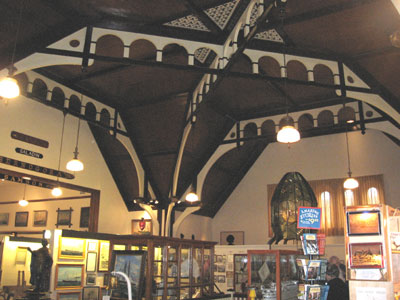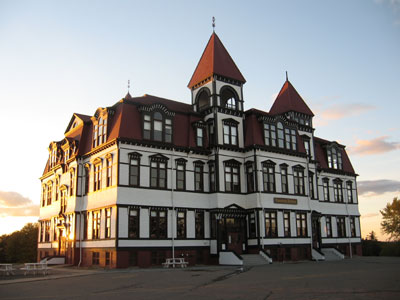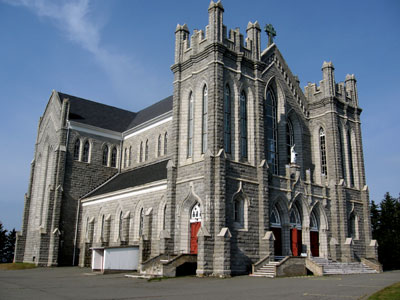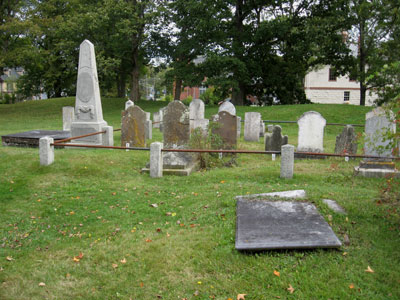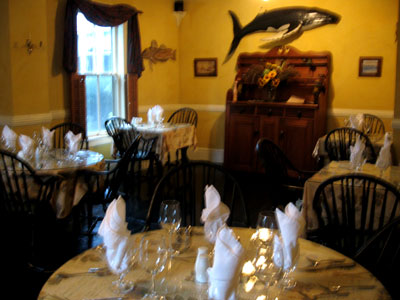On a dull drizzly morning I got a good start to my day with a filling breakfast and an interesting interview with the innkeepers of the MacKinnon-Cann in, followed by a tour of the four historic heritage properties that they own. In addition to last night’s walking tour of Yarmouth, I had now got a good idea of Yarmouth’s Victorian architecture. Now it was time to delve deeper into history, so I embarked on my visit of the Yarmouth County Museum and Archives.

The Yarmouth County Museum
Nadine Gates, the curator, welcomed me and gave me a personal tour throughout the facilities. As an overview she explained that the Yarmouth County Museum is a good representation of Yarmouth’s past. The town’s seafaring history is a major focus of the museum which features the third largest collection of ship portraits in Canada. More than 120 different ship portraits illustrate Yarmouth’s historic importance in shipbuilding and navigation.
The Yarmouth County Historical Society was founded in 1967, and the museum opened in 1969 in a former church building. Beautiful wooden beams across a high vaulted ceiling demonstrate the former ecclesiastical use of this building. The museum has been expanded twice in 1999 and 2004. The new wing we were standing in is called the Education Wing and hosts a variety of Historical Society meetings, talks and lectures, music recitals and other events and is open to the public. At the present time it is hosting a stained glass exhibit that features local artists.

The main area is a former church
From the Education Wing we entered the main section of the museum which is an impressive space with a very high ceiling. The main exhibit area (the former church) still exudes a solemn atmosphere. Nadine took me to an area called “Families at Sea”. Throughout seafaring history, particularly at the beginning of the previous century, entire families would be living on tall ships, and souvenirs from their trips all over the world were displayed here along with photos and letters of the various family members whose permanent residence was a wooden vessel on the ocean. A certain Catherine Ladd, for example, spent the first twelve years of her life living on a ship, and her artifacts are available for viewing.

Victorian dolls and dishes
Nadine also gave me a general explanation of Yarmouth’s history. The town was founded in the 1700s as an Acadian settlement whose residents were deported in the mid 1800s as part of the Grand Expulsion. Some Acadian settlers tried to escape deportation and hid in the forest with the Mi’kmaq native tribe. United Empire Loyalists were then assigned the land, and their economy focused on ship-building. This was the Golden Age of Sail, the Age of the Tall Ships. Today’s economy is based on fishing, and in particular lobster fishing. Interestingly, Nadine pointed out that years ago lobsters were only eaten by poor people and often they were used as cheap fertilizer in local gardens. How tastes change….
One area of the museum also features nameplates of ships. The most prominent and well-known one is the nameplate of the “Samson”. This ship was the closest ship to the sinking Titanic during the cold April days of 1912, and she heard the mayday calls of the sinking ocean liner. But because the Samson had been illegally fishing in the waters off Eastern Canada, the crew chose not to answer the distress call and left the area. We will never know how many more people could have been saved if the Samson had responded to this distress call. She was later renamed the “New York City”, a name that is still visible on the other side of the nameplate.

The nameplate of the ominous “Samson”
The Yarmouth County Museum is located right in the heart of Yarmouth’s Collins Street Heritage District. In addition to being a heritage property itself, the museum is surrounded by dozens of large homes owned formerly by wealthy sea captains and merchants. The Pelton-Fuller House next door was built as a summer home between 1890 and 1895 as a mansion for Alfred Fuller, a wealthy merchant, and was donated by one of his descendants in 1995 together with all its contents. Today it is part of the museum complex and an example of Victorian living.

High Victorian fashion
The Yarmouth County Museum has another off-site satellite location: the Killam Brothers Shipping Office is Canada’s oldest shipping office. In 1788 John Killam built his first schooner and started a family business that would span 203 years and five generations of the Killam family. The property was also donated to the Yarmouth County Historical Society, and the 19th century setting gives visitors an idea of a commercial office of the 1900s.

The former lens of the Cape Forchu Lighthouse
